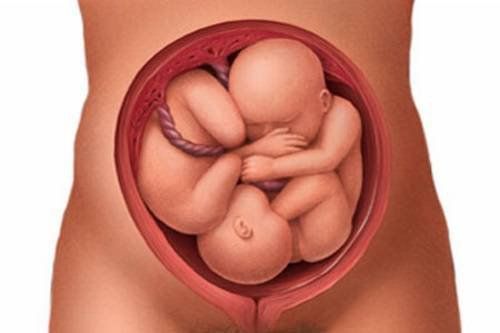Article reviewed by an Obstetrician and Gynecologist specialist, Department of Obstetrics and Gynecology, Vinmec Phu Quoc International General Hospital.
The fetal length and weight chart by week is a comprehensive reference guide that allows expectant mothers to monitor their baby’s development during pregnancy. This enables mothers to make necessary adjustments to their diet, exercise routines, and overall lifestyle to ensure optimal health for themselves and their baby.
1. International standard fetal weight chart
| Gestational age (weeks) | Length (cm) | Weight (g) | |
| Week 8 | 1.6 | 1 | |
| Week 9 | 2.3 | 2 | |
| Week 10 | 3.1 | 4 | |
| Week 11 | 4.1 | 45 | |
| Week 12 | 5.4 | 58 | |
| Week 13 | 6.7 | 73 | |
| Week 14 | 14.7 | 93 | |
| Week 15 | 16.7 | 117 | |
| Week 16 | 18.6 | 146 | |
| Week 17 | 20.4 | 181 | |
| Week 18 | 22.2 | 222 | |
| Week 19 | 24.0 | 272 | |
| Week 20 | 25.7 | 330 | |
| Week 21 | 27.4 | 400 | |
| Week 22 | 29 | 476 | |
| Week 23 | 30.6 | 565 | |
| Week 24 | 32.2 | 665 | |
| Week 25 | 33.7 | 756 | |
| Week 26 | 35.1 | 900 | |
| Week 27 | 36.6 | 1000 | |
| Week 28 | 37.6 | 1100 | |
| Week 29 | 39.3 | 1239 | |
| Week 30 | 40.5 | 1.396 | |
| Week 31 | 41.8 | 1.568 | |
| Week 32 | 43.0 | 1.755 | |
| Week 33 | 44.1 | 2000 | |
| Week 34 | 45.3 | 2200 | |
| Week 35 | 46.3 | 2.378 | |
| Week 36 | 47.3 | 2.600 | |
| Week 37 | 48.3 | 2.800 | |
| Week 38 | 49.3 | 3.000 | |
| Week 39 | 50.1 | 3.186 | |
| Week 40 | 51.0 | 3.338 | |
| Week 41 | 51.5 | 3.600 | |
| Week 42 | 51.7 | 3.700 |
The table provides estimated fetal length and weight at each week of gestation. For example, at week 33, the fetus typically weighs around 2 kg and measures 44.1 cm in length, while at week 34, the weight increases to approximately 2.2 kg, and the length to 45.3 cm.
The fetal weight tracking chart is designed to help expectant mothers closely monitor changes in their baby's development week by week. These standardized fetal weight measurements are provided for each week of gestation, starting from the 8th week and continuing through to the 40th week of pregnancy. After undergoing medical checkups and comparing the results with the fetal weight tracking chart, expectant mothers can determine whether their baby is growing appropriately. The chart helps identify if the fetus is smaller or larger than the standardized fetal weight benchmarks. Based on these insights, mothers can make necessary adjustments to their diet, nutrition, and exercise routines to ensure a healthy pregnancy and optimal fetal growth.
2. How to measure fetal length and weight by gestational age
The method of measuring fetal length and weight depends on the stage of pregnancy:
From week 8 to 19: The baby’s length is measured from the top of the head to the bottom of the buttocks.At this stage, the baby’s legs are bent in the womb, making it difficult to measure full body length. This length is also called as crown-rump length.
From week 20 to 42: The baby’s length is measured from head to heel. During this period, the baby’s weight and length steadily increase.
From week 32 onward: The baby’s weight increases significantly, and the final body features are completed.
3. Factors affecting fetal weight
There are various factors, both genetic and environmental, can affect fetal weight during pregnancy:
3.1. Genetic factors and ethnic differences
This means, the baby’s weight often reflects the parents’ body size and weight. Fetal weight standards can also vary across different ethnic groups and populations.
3.2. Maternal health during pregnancy
Mothers with conditions such as diabetes or obesity are more likely to have larger babies. Conversely, insufficient maternal weight gain or malnutrition may result in fetal growth restriction.This is shown through the weight index of the fetus while still in the womb.
3.3. Birth order
In fact, subsequent children are often larger than firstborns. However, if the interval between pregnancies is short, the second child may be smaller.
3.4. Number of fetuses
In cases of twins or multiple pregnancies, fetal weights are generally lower than those of singletons at the same gestational age.

4. Important notes about fetal weight standards
If the baby’s weight significantly deviates from the standard, it may indicate potential health concerns. So, pregnant mothers need to pay close attention.
If the fetus grows significantly larger than the standardized fetal weight chart on a weekly basis, particularly during the later months of pregnancy, it is possible that the baby is developing beyond the gestational age. When the fetus is excessively large, it can pose challenges during labor and delivery. If the baby's size exceeds the standard measurements by approximately 3 cm, the fetus may be at risk for conditions such as diabetes or obesity, even before birth.
If the fetal measurements are considerably smaller than the standardized fetal weight chart for the corresponding week of gestation, and the ultrasound indicates that the baby’s length is at least 3 cm shorter than the average, the expectant mother should promptly undergo further medical evaluations. The doctor may recommend additional tests to determine the cause. This could include assessing placental function to evaluate whether the placenta is delivering adequate nutrients to the fetus and checking for abnormalities in the umbilical cord.
The doctor will also ask detailed questions to evaluate whether your nutritional regimen is adequate for the fetus's development or if there are any factors negatively affecting your mental health. Once the underlying cause has been identified, the doctor will guide you on how to make appropriate adjustments, such as modifying your diet, ensuring sufficient rest, and practicing effective relaxation techniques. It is essential for the mother to implement these changes to improve the fetal weight.
If the fetus is underweight, the baby may suffer from malnutrition while still in the womb, making them more susceptible to respiratory illnesses and weakening their immune system after birth. Furthermore, this could potentially affect the child’s cognitive development later in life. Do not hesitate to seek advice, even through online consultations with your doctor, if you notice any unusual signs. This will allow the healthcare provider to address your concerns promptly and offer the necessary support.
5. Tips for Ensuring Healthy Fetal Weight Development

Eat a balanced diet rich in essential nutrients without overeating.
Maintain proper weight management to avoid excessive or insufficient weight gain during pregnancy. Throughout the entire pregnancy, an expected weight gain of 10–12 kg is considered appropriate for a single fetus. If you are carrying multiple fetuses, the recommended weight gain is approximately 16–20 kg. In the first trimester, weight gain should not exceed 1.5–2 kg. If the doctor identifies that you are underweight, it may be necessary to gain an additional 2 kg or more. Conversely, if you are overweight, it may not be essential to gain any weight during the first trimester, or at most, a weight gain of 1 kg. During the second trimester, from week 14 to week 28 of pregnancy, a weekly weight gain of approximately 0.5 kg is recommended. However, if you are overweight, you should aim to limit the weekly weight gain to around 0.2–0.3 kg to maintain a healthy balance.
Have a balanced regimen of rest and exercise to maintain both maternal and fetal health. Excessive stress or anxiety should be avoided, as these factors can negatively impact the fetus's weight and overall development.
Regular prenatal check-ups to understand the development and weight of the fetus by week, If there are significant deviations from the fetal weight standard charts, it is important to make adjustments based on the recommendations of doctor.
At Vinmec International General Hospital, comprehensive maternity care packages include detailed monitoring and management of fetal growth, minimizing the possibility of missing any fetal abnormalities. Some abnormalities can be treated during the fetal stage, while others may need to wait until after birth for intervention. At Vinmec, numerous challenging cases have been successfully resolved, including placenta accreta, umbilical cord knots, and pregnancy preservation.
Depending on the specific abnormality, you will receive step-by-step guidance and consultation, including necessary precautions during pregnancy, creating a birth plan, planning postnatal care for the baby, surgical treatment planning if required, and guidance on caring for the baby after discharge from the hospital.
Alongside accurate, scientific, and systematic prenatal examinations, the quality of ultrasound systems and modern medical equipment ensures prompt management of abnormalities during pregnancy and childbirth, allowing mothers to experience the safest pregnancy possible. The advanced ultrasound systems and modern medical equipment at Vinmec ensure the management of abnormalities during pregnancy, enabling mothers to have the safest pregnancy possible.
To arrange an appointment, please call HOTLINE or make your reservation directly HERE. You may also download the MyVinmec app to schedule appointments faster and manage your reservations more conveniently.












